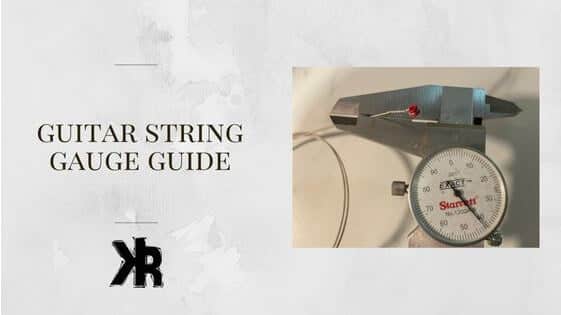Table of Contents
Guitar players all over the world experiment with different parts at some point. Even as beginners, we can’t help but want to modify our instruments. Strings are cheap and easy to change, so it’s usually one of the first areas of experimentation.
But if you change your string gauge, will your guitar be affected? Can it handle a thicker set of strings and still perform well? Many players experiment with this. But only to realize their instrument doesn’t play as well anymore.
In this Killer Rig article, we are going to look into the different gauges and learn how they affect our guitars. In terms of both sound and performance!
String Gauge Summary
| Thick Strings | Thin Strings |
|---|---|
| Better tuning stability | May go out of tune sooner |
| Harder to press | Easier to press |
| Louder | Quiet |
| Fuller Sound | Thinner sound |
| Longer string life | Shorter string life span |
| More tense | Less tension |
What is Guitar String Gauge?
Guitar string gauge refers to the thickness or diameter of each string on a guitar, an important factor that significantly influences both the playability and tonal quality of the instrument.
The gauge is measured in thousandths of an inch; for example, a string with a gauge of 10 has a diameter of 0.010 inches.
Importance of Gauge in Sound and Playability
The gauge of a string directly impacts the playing experience. Lighter gauges, such as 9 or 10, are generally easier to play and are often recommended for beginners.
They facilitate easier bending of notes, but may produce a thinner sound. On the other hand, heavier gauges like 13 or 14 offer a fuller, richer tone but require more finger strength and dexterity to manipulate effectively.
Variability Across Strings and Instruments
In a standard 6-string guitar, each string has a different thickness, contributing to the range of sounds produced when played.
This variability is not just limited to electric guitars; it applies universally across acoustic and bass guitars as well. Some string sets are designed for specific types of guitars or particular musical genres.
Practical Considerations
Most guitars come pre-strung with a standard set of strings, often referred to by the gauge of the high E string and the low E string, such as 10-46.
However, not all guitars can accommodate all string gauges, so it’s crucial to know your instrument’s limitations. Changing the gauge can alter the sound and playability, allowing you to tailor the instrument to your specific needs and preferences.
Types of Guitar String Gauges
Guitar string gauges come in a variety of sizes, each with its own set of characteristics that influence playability and sound.
Generally, these gauges are categorized into three main types: light, medium, and heavy. Below is a breakdown of these categories, along with some specialized types that cater to specific needs.
Light Gauge Strings
- Typical Range: 8-42 to 10-46
- Characteristics: Easier to play, suitable for fast fingerwork and bending notes.
- Best For: Beginners, lead guitarists, and genres requiring quick finger movement like rock and metal.
Medium Gauge Strings
- Typical Range: 11-49 to 12-54
- Characteristics: Balanced tone and playability, offering a mix of volume, sustain, and ease of play.
- Best For: Versatile players, rhythm guitarists, and those who play a mix of strumming and picking.
Heavy Gauge Strings
- Typical Range: 13-56 to 14-59
- Characteristics: Fuller, richer tone but require more finger strength.
- Best For: Jazz, blues, and genres requiring a fuller sound; also suitable for drop tunings.
Specialized Gauges
- Hybrid Gauge: Combines lighter treble strings with heavier bass strings, offering a balanced sound.
- Extra Light and Extra Heavy: These are the extremes, lighter than light and heavier than heavy, used for very specific needs.
- Custom Gauge: Some manufacturers offer the option to customize your set of string gauges.
Material Considerations
Different materials can also affect the gauge and, consequently, the sound and playability. Common materials include nickel, bronze, and steel. Each material interacts differently with the guitar’s pickups or body, affecting the overall sound.
Instrument-Specific Gauges
Some string gauges are designed specifically for certain types of guitars. Examples include 12-string, baritone, or bass guitars. These specialized sets ensure optimal sound and playability for these unique instruments.
Electric Guitars
Electric guitars normally use light to medium strings. But there are many thicknesses available, including hybrid sets for specific styles of playing.
It’s important to remember that as the string gets thicker, it also becomes tighter. This means that bending will become more difficult.
For a lead guitar player, this is detrimental. So finding the right string thickness is important. You need to retain a certain sound but still be able to perform bends.
Let’s take a look at some different electric guitar string gauges in the table below:
| String Set | E (High) | B | G | D | A | E (Low) |
|---|---|---|---|---|---|---|
| Super Extra Light | .008″ | .010″ | .015″ | .021″ | .030″ | .038″ |
| Super Light | .009″ | .011″ | .016″ | .024″ | .032″ | .042″ |
| Regular | .010″ | .013″ | .017″ | .026″ | .036″ | .046″ |
| Medium | .011″ | .014″ | .018″ | .027″ | .037″ | .048″ |
| Heavy | .012″ | .016″ | .020″ | .032″ | .042″ | .054″ |
Super light string sets are popular and may come on some guitars from the factory. This is because they provide a good balance of sound and performance. Fender uses them on their guitars because their customers are well-rounded players.
Hybrid Sets
There is also a set that is a mix of heavier strings for a deeper bass tone, and lighter ones for brightness. They are called heavy top, and light bottom. They are worth mentioning as the mix can be preferred over a full heavy set and are a bit of a hybrid.
These are great if you like to bend the brighter strings but want a good deep rhythm tone as well. They are not for everyone, but are worth trying if you just can’t find what you’re looking for. You can see the thickness of each string in this table below.
| Set | E | B | G | D | A | E |
|---|---|---|---|---|---|---|
| Heavy Top, Light Bottom | .010″ | .013″ | .017″ | .030″ | .042″ | .052″ |
Acoustic Guitars
Acoustic guitar string thicknesses are different from electric ones. They are designed to project more volume, and so they are thicker as a result. The most common sizes can be seen in this table:
| Set | E (High) | B | G | D | A | E |
|---|---|---|---|---|---|---|
| Extra Light | .010″ | .014″ | .023″ | .030″ | .039″ | .047″ |
| Light Strings | .011″ | .015″ | .023″ | .032″ | .042″ | .052″ |
| Medium | .012″ | .016″ | .025″ | .032″ | .043″ | .053″ |
| Heavy | .013″ | .017″ | .026″ | .035″ | .045″ | .056″ |
How To Measure String Gauge
To accurately measure your guitar strings, you will need a digital caliper tool. These tools are very affordable and easy to get. We recommend the Neiko digital caliper set. If you are going to be experimenting with gauges, it’s best to have this tool.
A digital caliper set is the best way to measure your guitar string gauge. This tool is designed for thin materials and is easy to use.
When using the caliper set, you first turn on your digital display. Then make sure it’s zero and go ahead and clamp a string in between the jaws. Once the caliper stops and can’t compress any further, you will be given a measurement on the display.
In my case, I went and measured the fifth string in this set. It has a red ball, which also helps me to realize what diameter it is. In the pictures below, you can see I used my calipers to measure the string. And I was able to get the same measurement that the package tells me.
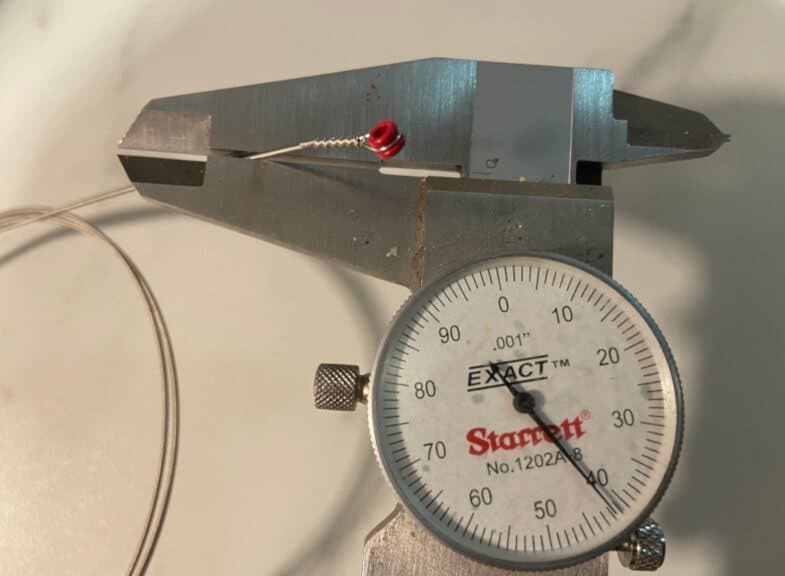
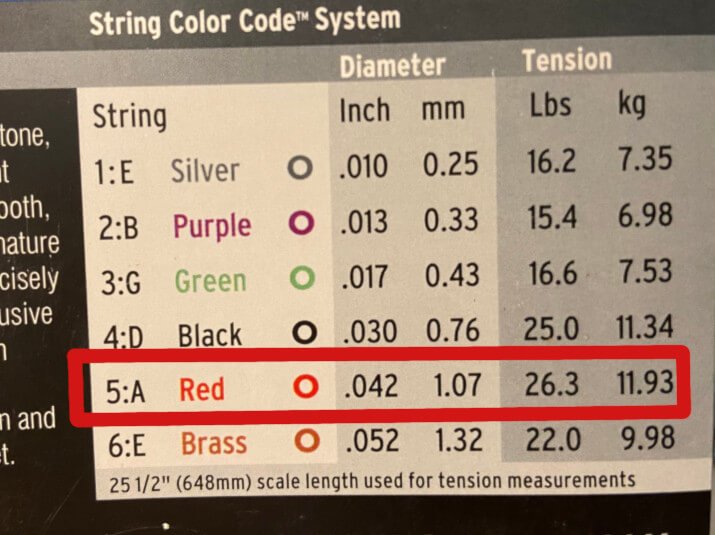
You can then perform this same process for all strings on your guitar and write them down. You will then know what you have and what you prefer. Every set you buy will have these sizes marked on the packages so that you can select your favorite.
Ever wondered how often you should change your guitar strings? Click here!
How Does String Gauge Affect a Guitar?
When trying different guitar string gauges, you will notice a difference in playability. It does depend on the level of thickness and how great the change.
But it’s wise to expect that if you change the gauge, the instrument will probably need a set-up. And don’t forget to recycle those old strings when you are done with them!
Some changes will greatly affect the guitar and some will not. And so in some cases, you will only need to adjust certain parts of the guitar. Let’s take a look at some of the adjustments that will more than likely need to be done.
Want to learn more about the different guitar string types? Click here!
Tension
We mentioned earlier that as a guitar’s string gauge increases, so does the tension. But how much more tense do they become?
When moving from super light to a regular set, the tension increase is nearly 20%! This extra tension will change the dynamics of your guitar. So much that it will require a set-up.
Then moving from regular to a medium set increases the tension by another 14%. That is nearly 39% tenser if moving from a super light set. This is all while tuning the strings to the same pitch.
It’s an incredible amount of tension and an increase in strain to your instrument. We want to make this point just so you understand what you may need to do to get your guitar back in a playable condition.
If you are interested in learning more about string tension, D’addario has a page that you may want to check out.
String Height
The space between the bottom of the strings and the top of the frets is a critical adjustment called action.
Depending on your guitar and the bridge installed, this gap could need adjustment. The playability of the guitar could become very difficult. Especially when a different string gauge is used.
The guitar action will be affected by a change to the string thickness. This is because a large jump will also affect the tension.
If you are going to a heavier set, there is a chance that the extra tension will increase the guitar’s action. This means that the strings will be farther away from the fretboard. But again, it depends on how much thicker they are.
If you are going from thick to thin, there will be less tension and the strings might be too close to the fretboard. So a set-up will be required in either instance, as the guitar might not be playable.
We have a great article about guitar action, click here!
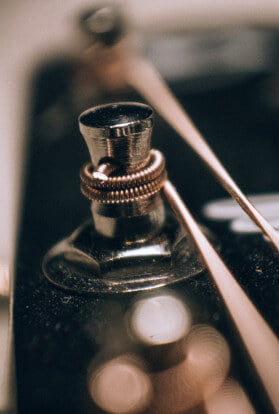
Tuning Stability
Changing to a different gauge will not necessarily affect the tuning stability. You will be able to tune the guitar just fine. But again, as we touched on above, the action will be the bigger issue due to the increase or decrease in tension.
Some guitars may have tuning issues if their parts are in poor condition or are not high quality. For example, the increase in tension might be more than a tuning head can hold if it’s in bad shape.
But a high-quality setup with good parts will not have instability issues when it comes to tuning. Each string note and name will be maintained.
Once the guitar is set up, staying in tune should be no problem. Granted, they have been wound in the right direction. The intonation might be out as a result. Which will make the instrument seem out of tune at different notes.
Intonation
Changing the string gauge will affect your guitar in many areas depending on the change. If you are changing from super light to heavy, you will notice an incredible change. Having it set up for the new set is a must if the change is drastic.
The intonation will only be lightly affected. Once the tension has been dealt with, the intonation will be quite close to where it was before the change.
The neck, however, will need to be looked at when changing gauges. So the intonation will normally level out once the action is set.
Acquiring a perfect intonation is difficult. When having a guitar set up, a slight adjustment will be done to the intonation if needed. But it depends on how bad it has become with the change in string gauge.
Guitar Nut Binding
Another thing to watch for when changing guitar string gauges is the nut. The nut on your guitar might not be able to efficiently hold the new thickness you have loaded. When players talk about tuning issues, in most cases it’s the nut that is binding or sticking.
If the nut is not up to the job, it could also break. So it’s very important to make sure the grooves for the strings are the correct size in order to prevent issues.

How Does String Gauge Affect Tone?
When a player decides to experiment with different gauges, it’s usually for the tone they make. Yes, the thickness also changes the way a guitar plays and feels, but it’s primarily all about the sound!
Sound is subjective, this much is true. But once we find the tone in our heads, we are more than likely prepared to sacrifice how the instrument plays. Guitarists who use heavy strings know that they are harder to bend and have higher tension. But the sound is right where they want it.
So you can’t have your cake and eat it too. But we can express ourselves and be quite content once we find our tone. Let’s take a look at some of the ways string gauge affects the sound.
Fullness
To a rhythm guitarist who seeks a thick sound, heavier is better. But to a player who likes to perform leads, the light gauge strings are where it’s at.
You can’t bend a thick string like you can a thin slinky one. The projection and substance of sound produced by a thicker set is quite different.
If you have ever heard the sound of a baritone guitar through a high-gain amplifier, it’s a force to be reckoned with! The warm, thick rhythm is quite the experience. So if you are looking for a full sound, then a thicker string set is what you want.
Here is a diagram that will show you the string gauges you should use for alternate tunings. This will give you the fullness of sound you desire!
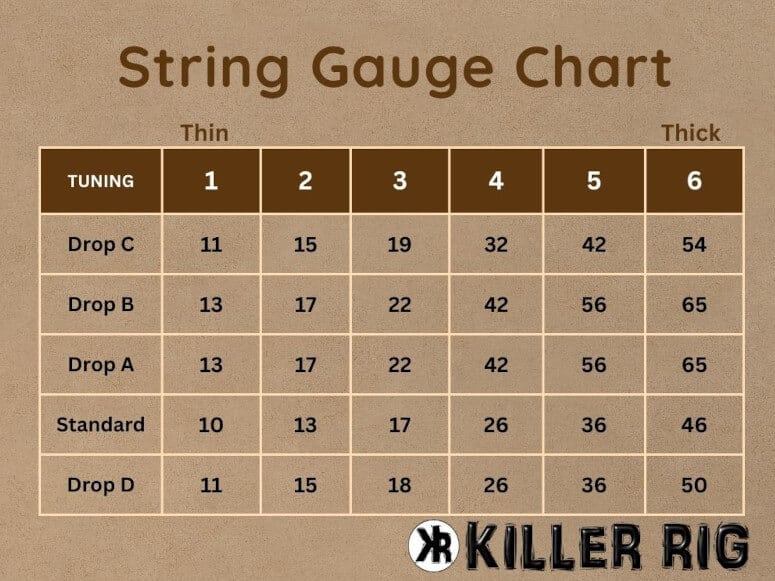
Volume
One of the primary benefits of a thicker gauge is volume. On an electric guitar, the heavier string set will provide a small increase to the pickup output. But it’s negligible at best. But when you are not plugged into an amplifier, the level will be noticeably louder.
This increase in volume from thicker strings is one of the main benefits. Now, this won’t compete with an amplifier, but you will notice a slight increase in volume. If you are trying to play quieter, however, you may not want to choose a thicker set.
Sustain
Because of the increase in guitar string gauge, one of the natural benefits is more note sustain. Sustain is the term used to describe the length of time a note will ring out. If you pluck a note and wait until you cannot hear it anymore, this is sustain.
Because of the extra material in a thicker string, it will continue to vibrate for a longer period. This is an increase in sustain.
To a lead player, this can be a real benefit, but you will need to find a gauge that you can bend well to bring it all together. Experimenting with different gauges is key.
Brightness
We have touched on the benefits of thick strings, but thin ones have their place too. Sometimes a thicker set can be a bit too warm or dark. If you are playing in a band, your guitar tone could get lost in the mix.
Lighter gauge strings are brighter and will help articulate your sound in a mix. This can be a big deal if you are a lead player and are trying to stand out. If you find that you need a brighter treble tone, try thinner strings.
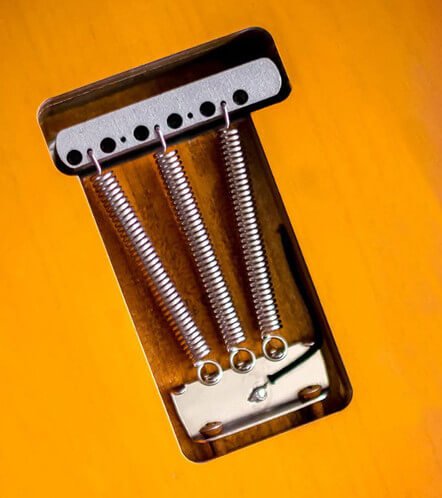
How to Choose the Right Gauge
Selecting the appropriate guitar string gauge is a crucial decision that can significantly impact your experience and the sound quality of your instrument. Here’s a comprehensive guide to help you make an informed choice.
Assess Your Playing Style
- Lead or Rhythm: Lighter gauges are generally better for lead guitarists who perform a lot of bends and fast fingerwork. Rhythm guitarists may prefer medium to heavy gauges for a fuller sound.
- Genre: The musical genre you specialize in can also guide your choice. For example, jazz and blues players often opt for heavier gauges, while rock and metal players may prefer lighter ones for easier playability.
Consider Your Skill Level
- Beginners: Lighter gauges are usually recommended for beginners due to their ease of play.
- Advanced Players: More experienced players may prefer medium or heavy gauges to achieve a specific tone or to match their playing style.
Know Your Instrument
- Guitar Type: Acoustic, electric, and bass guitars each have their own optimal string gauges. Make sure to select a gauge that is compatible with your type of guitar.
- Scale Length: The length of the guitar’s scale can affect string tension. Longer scale lengths may require heavier gauges to maintain the same tension.
Experiment and Adjust
- Trial and Error: Sometimes the best way to find the right gauge is through experimentation. Many players go through a phase of trying out different gauges before settling on the one that suits them best.
- Tuning: If you frequently use alternate tunings, you may need to adjust your string gauge to maintain proper tension.
Consult Manufacturer Guidelines
- Pre-Strung Gauges: Most guitars come pre-strung with a manufacturer-recommended gauge. This can serve as a starting point for beginners.
- Instrument Limitations: Not all guitars can handle all string gauges. Check the manufacturer’s guidelines to avoid damaging your instrument.
Additional Factors
- String Material: The material of the string can also affect playability and tone. Nickel, bronze, and steel are common materials, each with its own characteristics.
- Budget: While it may be tempting to opt for cheaper strings, investing in a quality set can improve playability and lifespan.
By considering these factors, you can select a string gauge that complements your playing style, skill level, and instrument, thereby enhancing your overall playing experience and sound quality.
What Gauge Strings Are Best for Drop Tuning?
Drop tuning is a technique often used in genres like metal, rock, and blues to achieve a deeper, heavier sound.
When you drop-tune your guitar, the string tension decreases, which can result in a “floppy” feel and reduced playability if you’re using lighter gauge strings. Therefore, choosing the right string gauge is crucial for maintaining optimal performance and sound quality.
Heavier Gauges for Lower Tension
In drop tuning, it’s generally advisable to use heavier gauge strings to compensate for the reduced tension. Heavier strings can maintain better tension and tonal integrity when tuned down.
- Typical Range: For most drop tunings, a set ranging from 11-54 to 13-62 is often recommended.
Genre-Specific Recommendations
- Metal and Rock: For genres that frequently use drop tunings like metal and hard rock, gauges ranging from 12-56 to 13-62 are commonly used to maintain a tight, focused sound.
- Blues and Jazz: In these genres, a medium-heavy gauge like 11-54 may suffice, as the focus is often on a fuller, warmer tone rather than tight, percussive articulation.
Custom Sets
Some players opt for custom gauge sets that mix heavier bass strings with lighter treble strings, offering a balanced feel and sound. This is particularly useful if you’re only dropping the tuning of specific strings.
Instrument Considerations
- Scale Length: Guitars with a longer scale length may require slightly lighter gauges to achieve the same tension as a shorter scale instrument.
- String Material: Heavier gauges made from materials like nickel or stainless steel can offer better sustain and durability, which is beneficial in drop tunings.
Test and Tweak
It’s always a good idea to experiment with different gauges to find what works best for your specific needs. Start with a heavier set and adjust according to your playing comfort and the tonal quality you aim to achieve.
Conclusion
When beginning to experiment with different guitar string gauges, take it slow. I suggest you move up one at a time and give each a chance.
It would be a shame to skip a thickness that could have been the right one for you and your play style. This will also allow you to test your guitar to see how far it can go.
Substantial modifications might be required when changing over. So it’s best to do it in stages. This way you will find what you like and still have a guitar with great playability!
Remember, your nut might not accept all thicknesses. Replace or upgrade them if needed to maintain proper tuning.
It’s also best to always take your instrument to a professional after each gauge change. Then, once you find your thickness, your guitar will be optimal as well!
FAQs
What Gauge Should a Beginner Use?
Anyone who is just getting started should stick with a lighter gauge string set. We know what it’s like to get started, seeking to learn your favorite songs. But when you are a beginner, it’s best not to put heavy gauge strings on your guitar.
They can be very difficult to play for a beginner and may even lead you to lose interest! That is the last thing you want to do. The guitar takes dedication and planning to learn properly. We suggest you stay focused using what works.
Light or regular sets are where a beginner should start until they have developed skill. Thicker strings will shred fingers that do not have calluses far worse than thin ones.
Are serious about improving your skills as a player? Then grab a set of these D’addario super lights and work on your technique. Stick with strings made by popular brands like D’addario and Ernie Ball for the best results.
Does String Gauge Matter?
Why does it matter? It’s another key we can use to unlock our tone. You see, the thickness we select will have pros and cons, just like anything else we do. If you are a bluesy, loud, fat-tone player, you will benefit from a thicker guitar string set.
If you are a lead player seeking a bright sound with a certain feel, you want a light and slinky.
When we can’t find the right set for our needs, how can we ever expect to express ourselves when we play? The guitar is a great instrument and exciting enough that the gauge could be overlooked.
But as a player, we know what we like! And I am quite sure my choice has allowed me to be more creative as a musician. It is perhaps a small detail to some.
But it’s a detail nonetheless. And when you find your favorite gauge, you will know what I mean. Playability, bending, and vibrato all feel different with each type of string.

